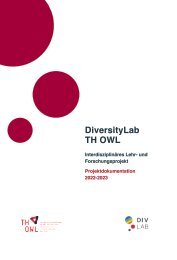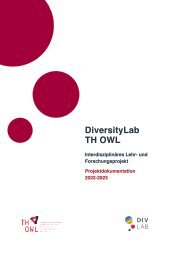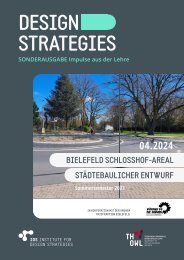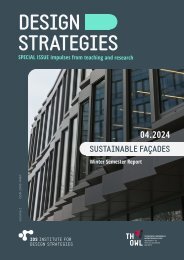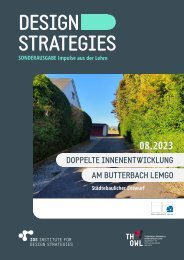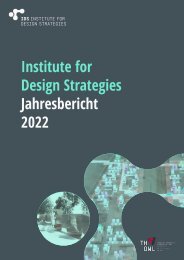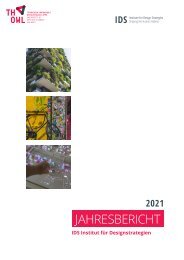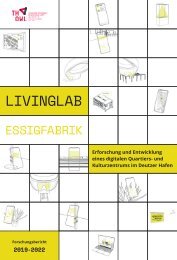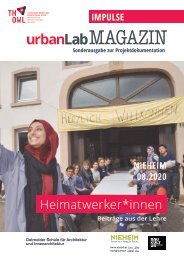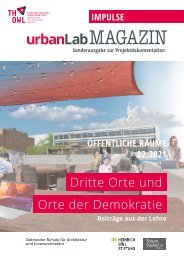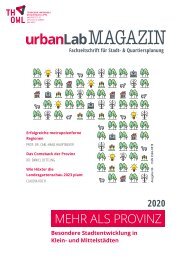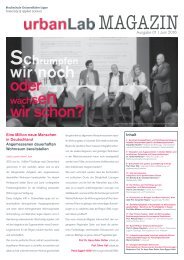urbanLab Magazin 2021 - Transformation
Sie wollen auch ein ePaper? Erhöhen Sie die Reichweite Ihrer Titel.
YUMPU macht aus Druck-PDFs automatisch weboptimierte ePaper, die Google liebt.
Interface overview<br />
dimensions of diversity in public spaces<br />
and calculate their resulting urban<br />
vitality. This benchmark can shed light<br />
on formerly unseen city life dimensions<br />
and help creating vital urban spaces.<br />
It is based on the diversity of people currently<br />
moving, their current objective,<br />
and the pedestrian flow related to time.<br />
Desired is a diverse, continuous pedestrian<br />
flow with little peaks or valleys in<br />
public places. The agents also make decisions<br />
on the mode of transportation.<br />
Taken into account for the calculation of<br />
the urban vitality are only pedestrians<br />
and bicycles, while cars have a negative<br />
influence on the vitality. The urban vitality<br />
is visualised as a heat map on the<br />
model. The surrounding with its buildings<br />
and building uses, citizens, public<br />
transportation, and parks is built up<br />
using data from Open Street Maps and<br />
the Offene Daten Köln - Initiative. Since<br />
the goal is to optimize urban vitality, the<br />
model has two interactive variables:<br />
The building uses of the future district<br />
and the demographics of the future<br />
district citizens. The users can modify<br />
these two variables using the tangible<br />
user interface and get feedback on their<br />
actions.<br />
3 TANGIBLE<br />
The tangible user interface (TUI) breaks<br />
this complex simulation down to<br />
a simple representation, combining a<br />
physical model with a projection. It serves<br />
as a visual feedback-based decision<br />
support model for participatory design.<br />
Therefore, it is important to be particularly<br />
clear and easy in the way of interacting<br />
with it and make sure to give a<br />
clear feedback.<br />
As mentioned by Kent Larson and Ariel<br />
Noyman (2017) from the CityScience<br />
group at the MIT Media Lab, TUIs were<br />
found to be much more approachable<br />
to people. Other solutions for participatory<br />
design such as touchscreen tables<br />
or even paper were still too complex<br />
and abstract for many participants and<br />
are also limited in the number of parallel<br />
users. The interface used here builds<br />
up on the CityScope projects from the<br />
MIT Media Lab (<strong>2021</strong>).<br />
From a technical point of view, the TUI is<br />
based on a pipeline that detects physical<br />
change of a model, translates it to a<br />
digital equivalent that triggers an action<br />
and connects the resulting digital information<br />
back to the physical object. In<br />
this case, the physical objects are so called<br />
tags and sliders. Tags describe the<br />
use of the buildings; the sliders make it<br />
possible to change the demographics of<br />
the district.<br />
In workshops, different stakeholders<br />
can modify these tags and sliders now<br />
to collaboratively develop the district<br />
and evaluate different situations regarding<br />
the urban vitality of the public places.<br />
Through the projection of the simulation,<br />
the users get a near to real-time<br />
feedback as well as a visual benchmark<br />
of the urban vitality. This helps creating<br />
a game-like experience.<br />
STUDENT IDEAS<br />
133




